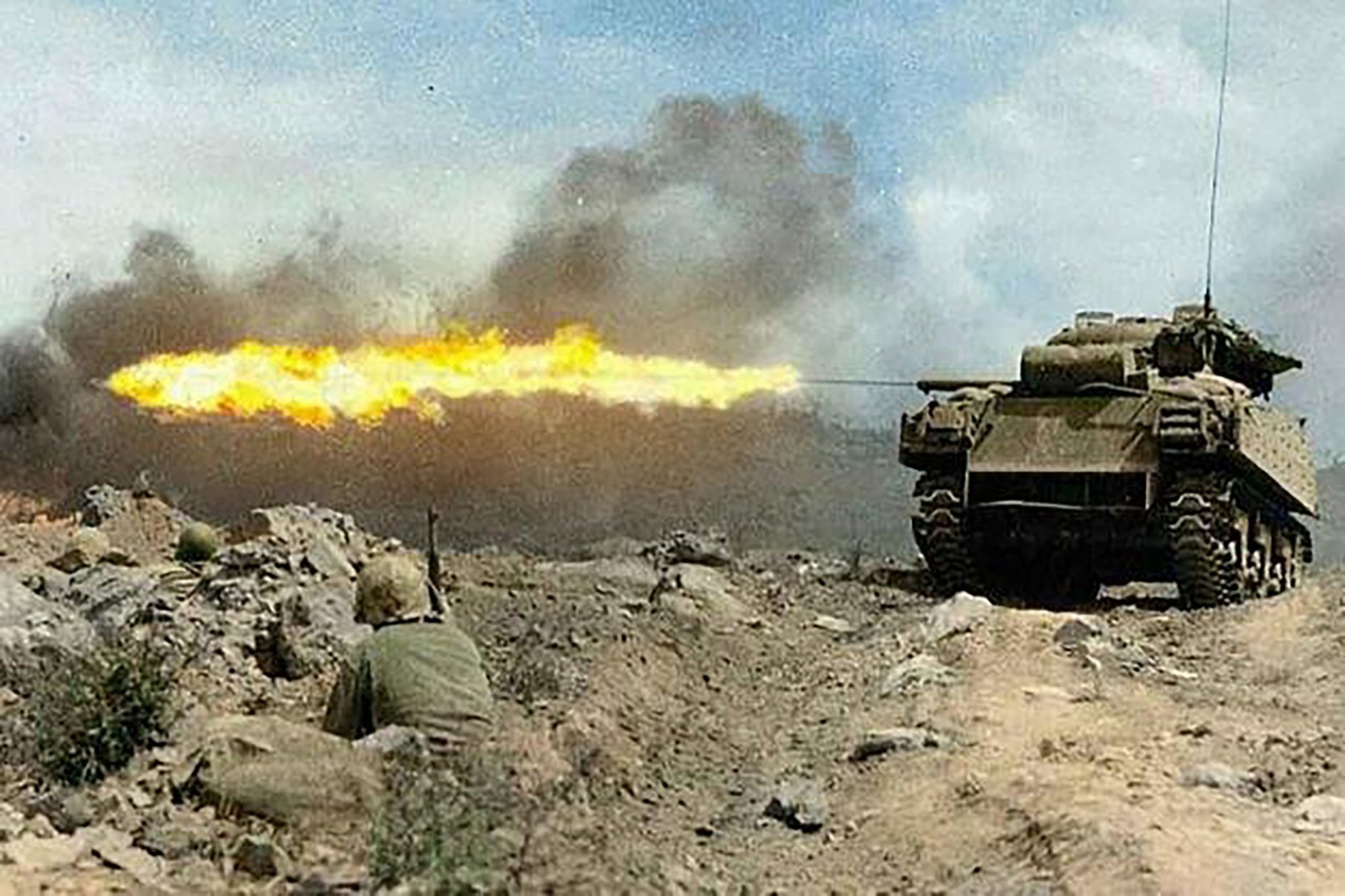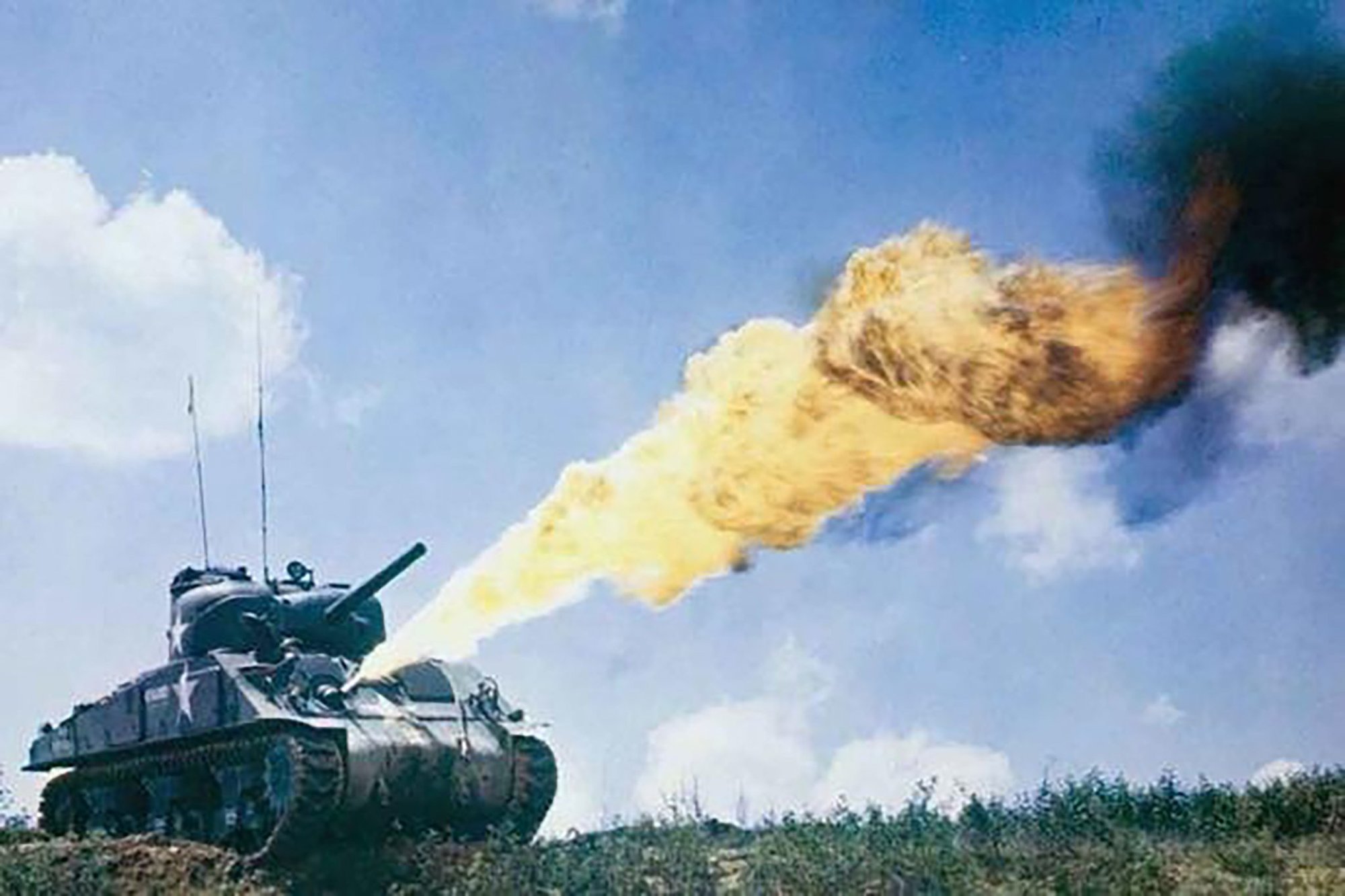
A Marine flame throwing tank, also known as a “Ronson”, scorches a Japanese strongpoint. The eight M4A3 Shermans equipped with the Navy Mark 1 flame-thrower proved to be the most valuable weapons systems on Iwo Jima. (Department of Defense/Mark Kauffman)
Read the original article on Military.com. Follow Military.com on Twitter.
Iwo Jima was a small but formidable target for the Allies in the Pacific Theater of World War II.
Japanese troops spent an entire year turning the island into a fortress. U.S. Marines would have to capture eight square miles of heavily fortified infantry and artillery positions, which included a network of pillboxes and bunkers above ground, along with 11 miles of reinforced concrete tunnels underground.
Those tunnels would make the island’s defenses almost impervious to Allied bombing and naval barrages. On top of all that, the Japanese had machine-gun nests, mortars and armor to push any landing back into the sea.
But the Marines were able to bring to bear a weapon that Japanese infantrymen actually feared: the modified Sherman M4A3 “Zippo” Tank, “the one weapon that caused the Japs to leave their caves and rock crevices and run,” according to a 1st Marine Division history article.
The U.S. couldn’t afford to hop over Iwo Jima, as it had many other Japanese-held islands. Aircraft on Iwo Jima could intercept bombers headed for the Japanese mainland and warn the home islands of incoming attacks. If American troops could capture the island, they could use it as a staging area for attacks on Japan and fly bombing missions with fighter escorts.
Read Next: New Marine Infantry Training Course Aims to Make Deadlier, More Independent Grunts
When Marines first landed on the beaches, they met light resistance and were able to gather forces for about an hour. That’s when the Japanese opened up on them in what one war correspondent called “a nightmare in hell.”
But the Marines brought their own nightmare to the fight. The M2 flamethrower used by Marine Corps infantry was a backpack-carried weapon effective in clearing out caves, pillboxes and other reinforced positions. It had proven itself to be an effective weapon in the fighting on Pacific Islands.
The problem was that the lifespan of a Marine wielding the flamethrower was roughly four minutes. Aside from the fact that they were carrying compressed gas and liquid fuel on their backs, the bright orange flames made them an attractive target for snipers. The close range required for its use made them extremely vulnerable to small-arms fire, and the cumbersome nature of the weapon forced them to move at a slower pace.
The solution was to mount the flamethrower on an armored vehicle.

After a few iterations of mounting flamethrowers onto light-armored vehicles in the Marianas and on Peleliu, U.S. Navy Seabees finally modified a Sherman M4A3 tank with the Mark-1 flamethrower. Marines now had an armored vehicle that fired napalm-thickened death through a 75mm main gun with a range of 150 yards.
The Navy was able to land all eight of its flamethrower tanks onto Iwo Jima on the first day, but they weren’t used until the second day of fighting. Once their effectiveness was realized, however, word quickly spread, and Marines held off their advances until the flaming Sherman tanks could be brought to bear.
“Zippo” tanks — as they came to be called — were much more effective against the caves and reinforced concrete than aerial bombardment or naval artillery. The Japanese troops did everything they could, including suicidal attacks, to stop the Shermans from torching their defenses. But the tanks kept on, dousing the defenders with about 10,000 gallons of napalm every day of the battle.
Fighting on Iwo Jima raged on for 36 days, killing nearly 7,000 Americans. Japanese deaths numbered around 18,000.
Capt. Frank C. Caldwell, a company commander with the 26th Marines, said of the modified flamethrower tanks, “In my view, it was the flame tank more than any other supporting arm that won this battle.”

Coffee or Die is Black Rifle Coffee Company’s online lifestyle magazine. Launched in June 2018, the magazine covers a variety of topics that generally focus on the people, places, or things that are interesting, entertaining, or informative to America’s coffee drinkers — often going to dangerous or austere locations to report those stories.
BRCC and Bad Moon Print Press team up for an exclusive, limited-edition T-shirt design!
BRCC partners with Team Room Design for an exclusive T-shirt release!
Thirty Seconds Out has partnered with BRCC for an exclusive shirt design invoking the God of Winter.
Lucas O'Hara of Grizzly Forge has teamed up with BRCC for a badass, exclusive Shirt Club T-shirt design featuring his most popular knife and tiomahawk.
Coffee or Die sits down with one of the graphic designers behind Black Rifle Coffee's signature look and vibe.
Biden will award the Medal of Honor to a Vietnam War Army helicopter pilot who risked his life to save a reconnaissance team from almost certain death.
Ever wonder how much Jack Mandaville would f*ck sh*t up if he went back in time? The American Revolution didn't even see him coming.
A nearly 200-year-old West Point time capsule that at first appeared to yield little more than dust contains hidden treasure, the US Military Academy said.












